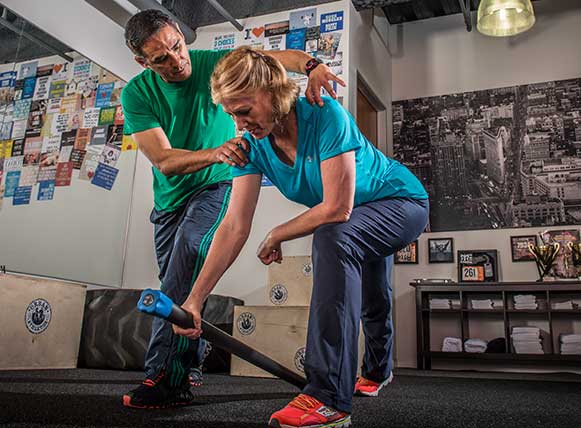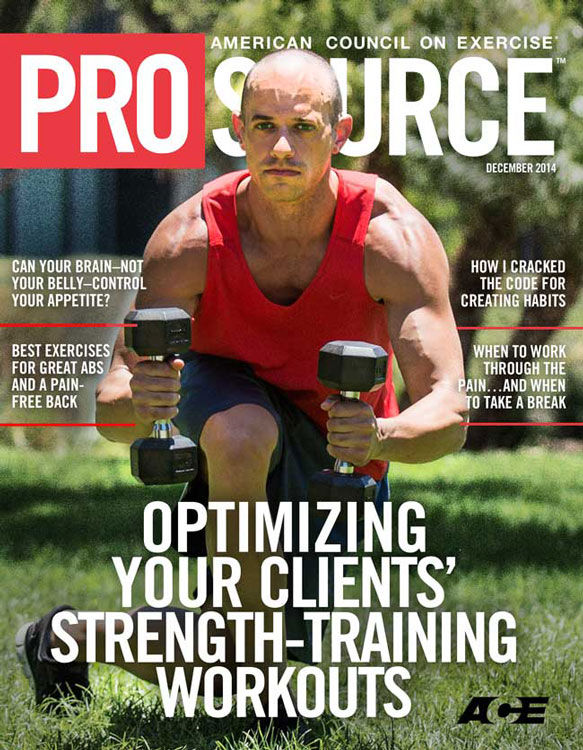
My clientele is largely comprised of amazing middle-aged and senior women who find it equally amazing when they realize how exercise helps them with daily activities—and then some. So imagine their dismay when they incur an injury or an old chronic one flares up. As their trainer, what would you recommend?
Pain is not a black-and-white issue. Part of where your response comes from will depend on where the pain is, how old it is and how severe it is. A client of mine recently presented with left shoulder pain from a falling injury that had occurred several months before. It seemed to be getting worse. The pain had increased and her range of motion (ROM) decreased. We removed any added resistance from the left side while performing her exercises and added light, dynamic ROM exercises. I also referred her to a sports medicine chiropractor. The chiropractor gave us the go-ahead to continue doing what we were doing, even adding back a little weight. She is now slowly regaining strength and ROM in that joint.
“If the injury is affecting what they do on a day-to-day basis, it should be looked at by a qualified professional,” recommends Rick Kaselj, M.S., owner of Exercises for Injuries out of Kelowna, British Columbia, Canada. “Or if you feel they do not have the physical conditioning, training level or skill, or could make an old injury worse with the training style you do—such as Crossfit, MMA training, etc.—get them to see a qualified professional and ask for exercise guidelines from that professional.”

Delayed Onset Muscle Soreness (DOMS)
This conversation would not be complete without at least touching upon delayed onset muscle soreness or DOMS. It is believed that DOMS is caused by eccentric work, which can cause microtears in the muscles and surrounding tissues, and hence, soreness and tenderness. It typically occurs 24 to 48 hours following a workout in which intensity was increased and the resistance load was more than the muscles are used to lifting. DOMS can be headed off by including a good, effective warm-up and gradual progression of resistance. But what if DOMS has already set in? Should your clients continue to work out?
It is best, says Kaselj, to rest, but keep moving. “Try to do low-level activity, like walking.”
But avoid more intense activity. DOMS is the body’s way of saying it needs time to heal and recover. Remember, there are microtears in the muscles. Because DOMS impairs athletic performance and strength, it is better to give the body the rest it needs so your client can get back to his or her normal level of activity within a few days; otherwise, your client may be benched for much longer.
While the jury is still out as to what definitively reduces DOMS, give your clients these suggestions a try and advise them to do what helps their bodies feel better.
Stay—or become—well-hydrated. Some believe this will help flush the body of any byproducts produced from higher-intensity exercise. Being well-hydrated also aids in flexibility, speaking of which...
Try massage and acupuncture. If paying for a massage, opt for a lighter touch. Now is not the time for deep tissue massage! Acupuncture can help block nerve pathways, thereby reducing the perception of pain.
Ice the affected area to help reduce inflammation; also try alternating heat therapy with ice therapy.
Apply a topical menthol ointment, such as Biofreeze, to sore muscles to help decrease pain.
If a client experiences DOMS on a regular basis, it might be a good idea to refer him or her to a physician or registered dietitian who can advise the client on appropriate nutritional therapies.
Some professionals prefer to err with the utmost caution. “It is never okay to work through the pain,” says Justin Price, creator of The Biomechanics Method. “However, many people do work through pain as their mind and ego like to override their body’s responses to achieve desired outcomes. But your body will always let you know—if you are paying attention to it—when it is time to take a break and not push through the pain.”
Although, he adds, due to the endorphin release and increased blood supply that comes with working out, “it is sometimes difficult to know when you have overdone it. As such, if you experience pain that lasts for more than five to seven days, it is time to ask a healthcare professional to check it out.”
Price recommends you take the opportunity to use a referral to a doctor or physical therapist to improve your own knowledge regarding musculoskeletal dysfunction and how it affects your client’s ability to exercise successfully. “As such, rather than make a referral to a physical therapist or doctor appear like a hassle to your client, you can help them focus on the enhanced service they will receive from you as a result,” Price explains.
“Too often today I think trainers and fitness enthusiasts adopt a ‘no pain, no gain’ mentality,” argues Brant Amundson, Muscle Activation Techniques (MAT) specialist and owner of Muscle Mechanic, LCC, in New York, N.Y. “They constantly push through joint and muscle issues until they get seriously injured or gradually lose the ability to know what it feels like to move and function properly.”
According to Todd Sinett, D.C., inventor of The Backbridge™ System and author of The Truth about Back Pain, there are some specific symptoms that require an immediate halt to exercise. “Numbness or any sign of tingling is a sign of nerve irritation. If you are experiencing any of these symptoms you should stop the exercise immediately and consult with your doctor. Another red flag is that when working out you shouldn’t experience pain when performing a particular exercise. If you do, stop immediately. Yes, the exercise can be difficult and burn, but it should not be painful.”
Amundson suggests taking the following guidelines into consideration when dealing with clients and pain:
- Cautiously push through when the pain or discomfort gradually dissipates as you continue the activity OR if you’ve taken an immediate break from the “problematic activity” and done some other movement to address the issue and the pain goes away and stays away when you resume the activity. “You can also continue on,” adds Kaselj, “if it feels like general muscle soreness and you have full range of motion of the joint when it is unloaded.”
- Stop when then pain gets worse or stays the same during the activity.
- See (or refer to) a qualified professional when you notice a consistent limit in ROM from one side of the body to the other (with or without pain). “For example, if your shoulder flexion is consistently limited on one side, chances are you have a muscular inhibition in those shoulder muscles.” The same goes for chronic tightness or soreness in a particular muscle or joint.
“Trainers can all agree that there’s a fine line between working out through discomfort and working out through the pain,” concludes Trish DeCosta, founder of Love Life Fit, based out of San Diego, Calif. “The popularity of high-intensity exercise may even perpetuate the idea that working out through pain is ‘tough’ or necessary to get great results. It simply isn’t. What’s more is that trainers are usually the worst culprits at taking breaks, and the signs to slow down or stop altogether are usually all there before an injury occurs.”
Sinnett agrees. “Doctors operate by the creed, “First do no harm.’ I believe trainers should develop this mentality as well. Doing too little is better than doing too much. Focusing on the long-term goals of health and fitness is a great way to keep your clients healthy. Slow and steady wins the race!”





 by
by 



